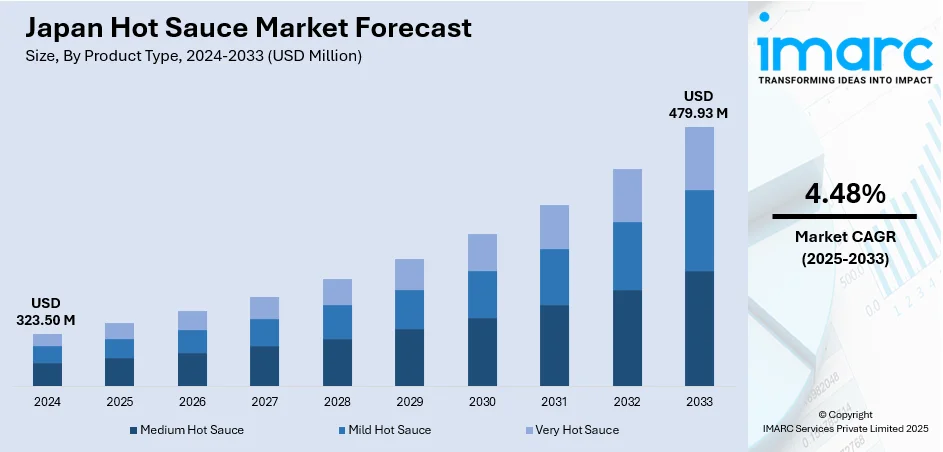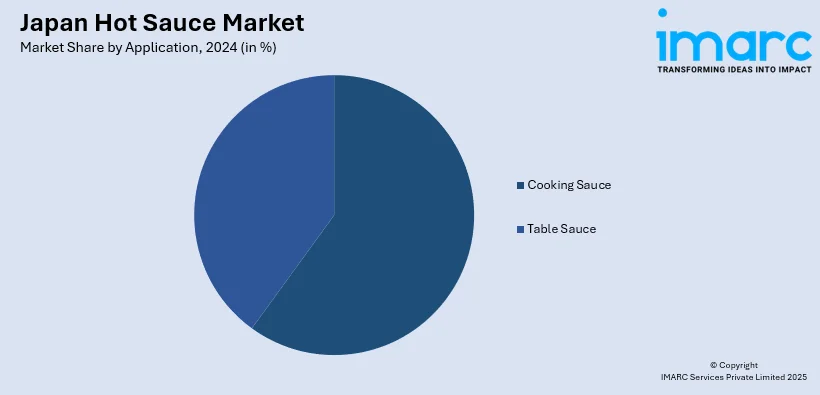
Japan Hot Sauce Market Size, Share, Trends and Forecast by Product Type, Application, Packaging, Distribution Channel, End Use, and Region, 2025-2033
Japan Hot Sauce Market Overview:
The Japan hot sauce market size reached USD 323.50 Million in 2024. Looking forward, IMARC Group expects the market to reach USD 479.93 Million by 2033, exhibiting a growth rate (CAGR) of 4.48% during 2025-2033. Consumer behavior and diet in Japan are being drastically impacted by globalization, with a deepening desire for international foods. Apart from this, the country’s growing emphasis on healthy dining is increasing interest in spicy food products. Additionally, the rise in the emergence of foodservice platforms is expanding the Japan hot sauce market share.
|
Report Attribute
|
Key Statistics
|
|---|---|
|
Base Year
|
2024 |
|
Forecast Years
|
2025-2033
|
|
Historical Years
|
2019-2024
|
| Market Size in 2024 | USD 323.50 Million |
| Market Forecast in 2033 | USD 479.93 Million |
| Market Growth Rate 2025-2033 | 4.48% |
Japan Hot Sauce Market Trends:
Growing Globalization and International Cuisines Exposure
Consumer behavior and diet in Japan are being drastically impacted by globalization, with a deepening desire for international foods. The introduction of varied culinary flavors, especially from Latin America, the United States, and Southeast Asia, is creating a major demand for hot sauces. While Japan's food culture is adopting worldly flavors, hot sauces are emerging as compulsory sidekicks to foods, lending them a peppery twist to their taste. This increasing trend of cross-cultural food fusion, particularly in cities where people from different backgrounds live together, is broadening the attractiveness of hot sauces. Hot sauces are also gaining popularity due to the international food chains and restaurants popularizing spicy cuisine, raising awareness about hot sauces amongst consumers in Japan. Consequently, domestic producers and global brands are diversifying their hot sauce products to meet this changing demand. In 2025, Japan’s first craft hot sauce store opened in the Harajuku area. Hot Sauce Bar presents a selection of both international and local hot sauces, having reached more than 300 pop-up spots since its inception.

To get more information on this market, Request Sample
Increased Interest in Health and Wellness Trends
Japan's growing emphasis on healthy dining is increasing interest in spicy foods, further impelling the Japan hot sauce market growth. Capsaicin, the heat-inducing chemical in hot sauces, is used for its ability to boost metabolism and provide weight management benefits. Capsaicin is also associated with better cardiovascular health, anti-inflammatory effects, and antioxidant properties. All these benefits are finding favor with Japanese consumers who are increasingly turning to functional foods as part of their health-conscious lifestyle. The growing popularity of health diets like low-calorie and high-protein diets is leading to increased use of hot sauce among many consumers as a tasty and healthy substitute for normal condiments. Due to this, hot sauces, especially the ones based on natural and organic products, are in high demand among health-aware consumers in Japan.
Expansion of the Foodservice Platforms
Japan's foodservice market is driving the demand for hot sauces. As international restaurants, food trucks, fast-casual dining chains, and fusion-style restaurants are rising, the availability of spicy food items is increasing. Foodservice companies are more aggressively adding hot sauces to their offerings, especially as burger condiments, fried chicken, sandwiches, and tacos. As consumers seek more varied, flavorful meals, restaurants are answering by introducing varieties of hot sauce to cater to various spice tolerance levels. Also, food delivery businesses are facilitating the spread of new hot sauce brands and spicy dishes to a broader consumer base. This growth in the foodservice industry not only generates a consistent need for hot sauces but also invites consumers to try out various brands and flavors. Consequently, foodservice outlets are serving as key drivers of hot sauce consumption, hence contributing to the market growth. IMARC Group predicts that the Japan food service market is anticipated to exhibit a growth rate (CAGR) of 10.29% during 2025-2033.
Japan Hot Sauce Market Segmentation:
IMARC Group provides an analysis of the key trends in each segment of the market, along with forecasts at the country and regional levels for 2025-2033. Our report has categorized the market based on product type, application, packaging, distribution channel, and end use.
Product Type Insights:
- Medium Hot Sauce
- Mild Hot Sauce
- Very Hot Sauce
The report has provided a detailed breakup and analysis of the market based on the product type. This includes medium hot sauce, mild hot sauce, and very hot sauce.
Application Insights:

- Cooking Sauce
- Table Sauce
A detailed breakup and analysis of the market based on the application have also been provided in the report. This includes cooking sauce and table sauce.
Packaging Insights:
- Jars
- Bottles
- Others
A detailed breakup and analysis of the market based on the packaging have also been provided in the report. This includes jars, bottles, and others.
Distribution Channel Insights:
- Supermarkets and Hypermarkets
- Traditional Grocery Retailers
- Online Stores
- Others
A detailed breakup and analysis of the market based on the distribution channel have also been provided in the report. This includes supermarkets and hypermarkets, traditional grocery retailers, online stores, and others.
End Use Insights:
- Commercial
- Household
A detailed breakup and analysis of the market based on the end use have also been provided in the report. This includes commercial and household.
Regional Insights:
- Kanto Region
- Kansai/Kinki Region
- Central/ Chubu Region
- Kyushu-Okinawa Region
- Tohoku Region
- Chugoku Region
- Hokkaido Region
- Shikoku Region
The report has also provided a comprehensive analysis of all the major regional markets, which include Kanto Region, Kansai/Kinki Region, Central/ Chubu Region, Kyushu-Okinawa Region, Tohoku Region, Chugoku Region, Hokkaido Region, and Shikoku Region.
Competitive Landscape:
The market research report has also provided a comprehensive analysis of the competitive landscape. Competitive analysis such as market structure, key player positioning, top winning strategies, competitive dashboard, and company evaluation quadrant has been covered in the report. Also, detailed profiles of all major companies have been provided.
Japan Hot Sauce Market Report Coverage:
| Report Features | Details |
|---|---|
| Base Year of the Analysis | 2024 |
| Historical Period | 2019-2024 |
| Forecast Period | 2025-2033 |
| Units | Million USD |
| Scope of the Report |
Exploration of Historical Trends and Market Outlook, Industry Catalysts and Challenges, Segment-Wise Historical and Future Market Assessment:
|
| Product Types Covered | Medium Hot Sauce, Mild Hot Sauce, Very Hot Sauce |
| Applications Covered | Cooking Sauce, Table Sauce |
| Packagings Covered | Jars, Bottles, Others |
| Distribution Channels Covered | Supermarkets and Hypermarkets, Traditional Grocery Retailers, Online Stores, Others |
| End Uses Covered | Commercial, Household |
| Regions Covered | Kanto Region, Kansai/Kinki Region, Central/ Chubu Region, Kyushu-Okinawa Region, Tohoku Region, Chugoku Region, Hokkaido Region, Shikoku Region |
| Customization Scope | 10% Free Customization |
| Post-Sale Analyst Support | 10-12 Weeks |
| Delivery Format | PDF and Excel through Email (We can also provide the editable version of the report in PPT/Word format on special request) |
Key Questions Answered in This Report:
- How has the Japan hot sauce market performed so far and how will it perform in the coming years?
- What is the breakup of the Japan hot sauce market on the basis of product type?
- What is the breakup of the Japan hot sauce market on the basis of application?
- What is the breakup of the Japan hot sauce market on the basis of packaging?
- What is the breakup of the Japan hot sauce market on the basis of distribution channel?
- What is the breakup of the Japan hot sauce market on the basis of end use?
- What is the breakup of the Japan hot sauce market on the basis of region?
- What are the various stages in the value chain of the Japan hot sauce market?
- What are the key driving factors and challenges in the Japan hot sauce market?
- What is the structure of the Japan hot sauce market and who are the key players?
- What is the degree of competition in the Japan hot sauce market?
Key Benefits for Stakeholders:
- IMARC’s industry report offers a comprehensive quantitative analysis of various market segments, historical and current market trends, market forecasts, and dynamics of the Japan hot sauce market from 2019-2033.
- The research report provides the latest information on the market drivers, challenges, and opportunities in the Japan hot sauce market.
- Porter's five forces analysis assist stakeholders in assessing the impact of new entrants, competitive rivalry, supplier power, buyer power, and the threat of substitution. It helps stakeholders to analyze the level of competition within the Japan hot sauce industry and its attractiveness.
- Competitive landscape allows stakeholders to understand their competitive environment and provides an insight into the current positions of key players in the market.
Need more help?
- Speak to our experienced analysts for insights on the current market scenarios.
- Include additional segments and countries to customize the report as per your requirement.
- Gain an unparalleled competitive advantage in your domain by understanding how to utilize the report and positively impacting your operations and revenue.
- For further assistance, please connect with our analysts.
 Request Customization
Request Customization
 Speak to an Analyst
Speak to an Analyst
 Request Brochure
Request Brochure
 Inquire Before Buying
Inquire Before Buying




.webp)




.webp)












